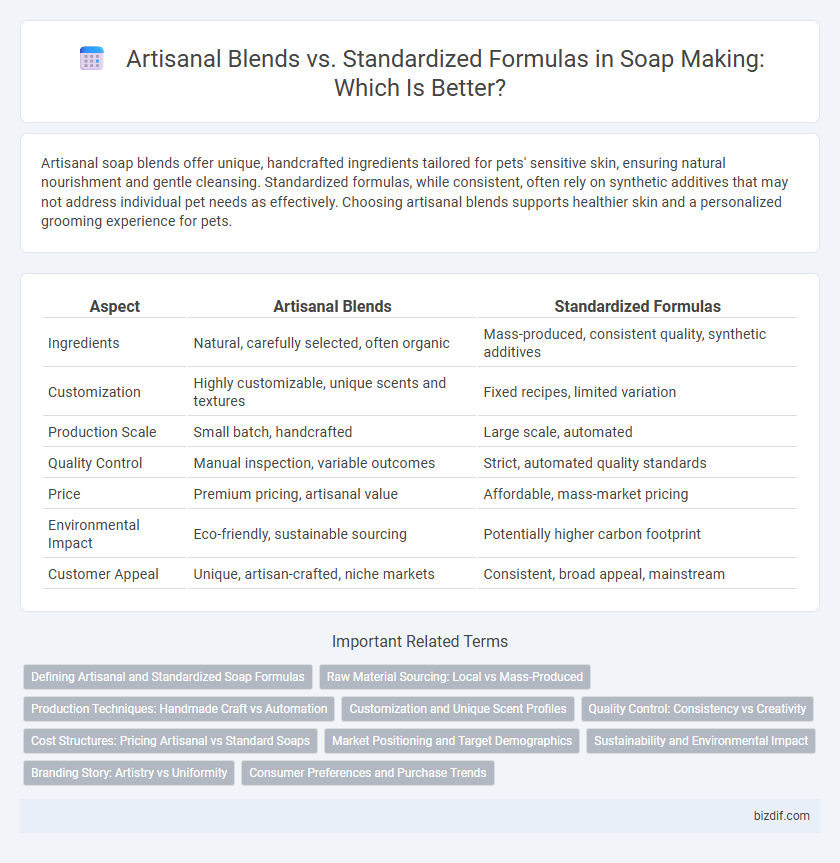Artisanal soap blends offer unique, handcrafted ingredients tailored for pets' sensitive skin, ensuring natural nourishment and gentle cleansing. Standardized formulas, while consistent, often rely on synthetic additives that may not address individual pet needs as effectively. Choosing artisanal blends supports healthier skin and a personalized grooming experience for pets.
Table of Comparison
| Aspect | Artisanal Blends | Standardized Formulas |
|---|---|---|
| Ingredients | Natural, carefully selected, often organic | Mass-produced, consistent quality, synthetic additives |
| Customization | Highly customizable, unique scents and textures | Fixed recipes, limited variation |
| Production Scale | Small batch, handcrafted | Large scale, automated |
| Quality Control | Manual inspection, variable outcomes | Strict, automated quality standards |
| Price | Premium pricing, artisanal value | Affordable, mass-market pricing |
| Environmental Impact | Eco-friendly, sustainable sourcing | Potentially higher carbon footprint |
| Customer Appeal | Unique, artisan-crafted, niche markets | Consistent, broad appeal, mainstream |
Defining Artisanal and Standardized Soap Formulas
Artisanal soap formulas emphasize handcrafted techniques using natural, often locally sourced ingredients with unique scents and textures tailored for small batches. Standardized soap formulas prioritize consistency, scalability, and uniform quality by following precise, replicable measurements and industrial processes. These differences impact the customization, ingredient variety, and production volume between artisanal and standardized soaps.
Raw Material Sourcing: Local vs Mass-Produced
Artisanal soap makers prioritize raw material sourcing from local farms and small-scale producers, ensuring fresh, high-quality ingredients with traceable origins that enhance the uniqueness and sustainability of each batch. In contrast, standardized formulas typically rely on mass-produced raw materials sourced from global suppliers, favoring consistency and cost-efficiency but potentially sacrificing ingredient purity and environmental impact. The choice between local and mass-produced raw materials significantly influences the soap's texture, fragrance, and eco-friendly credentials, making sourcing a critical factor in artisanal versus commercial soap production.
Production Techniques: Handmade Craft vs Automation
Artisanal soap making emphasizes handmade craft techniques, allowing for precise control over ingredient quality and small-batch customization that preserves unique fragrances and textures. In contrast, standardized formulas rely on automation to ensure consistent production, scalability, and uniform product characteristics across large volumes. The choice between artisanal blends and standardized formulas directly impacts the production process, balancing creativity and individuality against efficiency and repeatability.
Customization and Unique Scent Profiles
Artisanal soap blends offer unparalleled customization, allowing creators to experiment with unique scent profiles and ingredient combinations tailored to individual preferences. Unlike standardized formulas, which prioritize consistency and mass production, artisanal blends emphasize originality and the use of high-quality, natural ingredients. This approach results in distinctive soaps with complex aromas and personalized benefits that cater to niche markets and sensory experiences.
Quality Control: Consistency vs Creativity
Artisanal soap blends emphasize creativity and unique ingredient combinations, allowing for diverse textures, scents, and benefits tailored to niche preferences. Standardized formulas prioritize consistency in quality control, ensuring each batch meets exact specifications for uniform appearance and performance. Balancing these approaches impacts product reliability and consumer trust in the soap-making industry.
Cost Structures: Pricing Artisanal vs Standard Soaps
Artisanal soap blends often incur higher production costs due to handcrafted processes, premium natural ingredients, and smaller batch sizes, which drive up their retail prices. Standardized soap formulas benefit from economies of scale, automated manufacturing, and bulk ingredient purchases, resulting in lower cost structures and more affordable pricing. Consumers typically pay a premium for artisanal soaps reflecting their unique formulations, quality craftsmanship, and limited availability.
Market Positioning and Target Demographics
Artisanal soap blends attract niche consumers seeking unique, handcrafted products with natural ingredients and customizable scents, positioning themselves as premium, eco-conscious options. Standardized formulas cater to mass markets by offering consistent quality, affordability, and widely recognized brands, appealing primarily to price-sensitive and convenience-driven buyers. Market segmentation reveals artisanal soaps thrive in boutique stores and artisanal markets, while standardized soaps dominate supermarkets and online retail platforms.
Sustainability and Environmental Impact
Artisanal soap blends use sustainable, ethically sourced natural ingredients minimizing chemical pollution and supporting biodiversity, while standardized formulas typically rely on synthetic compounds with higher environmental footprints. Crafting soaps in small batches reduces waste and energy consumption compared to mass-produced standardized soaps. Emphasizing biodegradable ingredients in artisanal blends enhances soil and water health, promoting eco-friendly skincare solutions.
Branding Story: Artistry vs Uniformity
Artisanal soap blends emphasize unique, handcrafted ingredients that convey a story of creativity and personal touch, appealing to consumers seeking authenticity and individuality. Standardized formulas ensure consistent quality and appearance, reinforcing brand reliability and uniformity across all products. Leveraging the artistry of artisanal blends enriches brand identity by highlighting craftsmanship, while standardized formulas underpin trust through predictable, repeatable results.
Consumer Preferences and Purchase Trends
Artisanal soap blends often attract consumers seeking unique, handcrafted products with natural ingredients, reflecting a growing trend toward personalized skincare solutions. Standardized formulas appeal to buyers prioritizing consistency, affordability, and widely recognized brands, dominating mass-market sales. Market analyses show increasing consumer preference for artisanal blends in niche segments, while standardized soaps maintain volume leadership through extensive distribution channels.
Artisanal Blends vs Standardized Formulas Infographic

 bizdif.com
bizdif.com